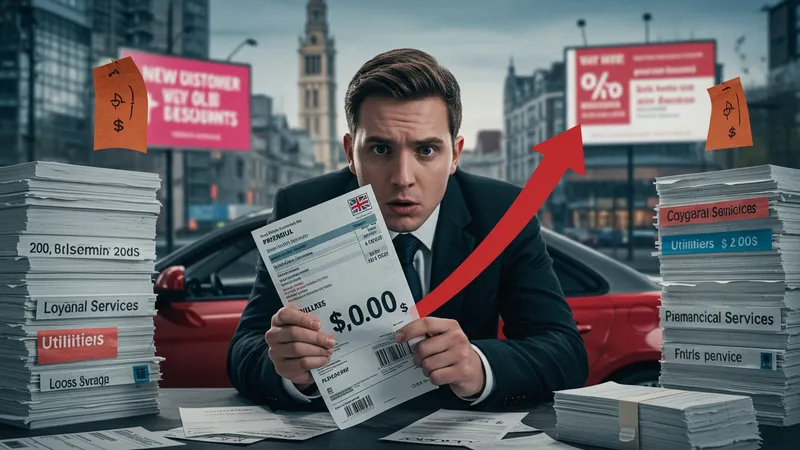

You won’t believe how one simple choice could save British drivers thousands of pounds yearly on car insurance! Yes, you read that right. A staggering opportunity exists that most are entirely unaware of.
In a rapidly changing financial landscape, knowing these hidden truths about car insurance is essential now more than ever. British drivers: it's time to rethink what you know about protecting your car and your wallet.

Did you know that nearly 70% of British drivers are overpaying on their car insurance due to outdated myths and half-truths perpetuated by the industry? Many still believe that loyalty rewards them with better rates, but data shows the contrary. In fact, staying with one insurer too long often results in skyrocketing premiums. But that’s not even the wildest part…
An alarming study recently revealed that gender, despite EU regulations, still subtly influences insurance quotes in the UK. Men, on average, pay up to 20% more than their female counterparts. This discrepancy, cloaked in seemingly neutral risk assessments, is costing men hundreds each year. But here’s where it gets even more intriguing…
What happens next shocked even the experts. Dive in to discover the unspoken rules that industry insiders don't want you to know about. Unlock the secrets now, and you might just change the way you see car insurance premiums forever.
Understanding car insurance terms can be incredibly frustrating for British drivers who are not accustomed to the overwhelming jargon thrown their way. Many policies use complex language that leaves drivers scratching their heads. Terms like 'excess', 'premium', and 'third-party coverage' dance before their eyes without much clarity. But don’t worry, here’s a revelation: insurance companies benefit from this confusion. The less you know, the more you might unknowingly pay. But there’s one more twist…

Did you know that some insurance providers create this wall of words to dissuade you from digging deeper into what exact benefits you are entitled to? It’s a tactical move that keeps many drivers passive and uninformed. By simplifying industry terms, drivers can take control back and potentially save a fortune. But the real trick is spotting these self-serving obfuscations. Want to know how this simple knowledge twist can empower you? Keep reading…
The art of decoding these confounding terms isn’t just about understanding what each word means. It’s about comprehending what the absence of certain terms might imply for a policy. As British drivers get savvier, they begin to ask the uncomfortable questions that force insurers into transparency. Suddenly those hidden clauses come to light, transforming passive customers into informed consumers. And that’s just the beginning of the revolution…
This new-found knowledge allows drivers to weigh up the offerings from numerous providers without being misled by flowery language. Once you grasp the basics, you unlock the potential to beat insurers at their own game. This insider information could mean the difference between sticking with an expensive policy and snagging the deal of your dreams. What you read next might change how you see insurance policies forever.
Did you know that your postcode could be one of the biggest factors affecting your insurance premium in the UK? Insurers often rely on data-driven models that covertly factor in location when calculating quotes. Areas with higher crime rates, traffic congestion, or even complex road layouts could result in a drastic increase in your costs. But that's not the full story...

Not only does location affect the likelihood of theft or accidents, but it also reflects the insurer’s dataset encompassing crime prevalence, historical claims, and local traffic incident reports. While this might be understood at a surface level, there are deeper implications. For instance, living near a school might raise your premium due to the perceived risk of increased traffic. The real surprise, however, lies in how some suppliers prioritize data over your actual driving behavior.
A shocking insider tip reveals that some insurers track your movement to offer discounts based on your mobility patterns. Using telematics or 'black box' technology, they assess your driving habits, regardless of your postcode. A careful driver in a risky area could still pay less than a reckless driver in a low-risk zone. Here's the kicker though: the implementation of this tech isn't universal, and it's crucial to know if your provider offers it.
Understanding these details could dramatically alter the perception of car insurance pricing. The next time you consider a policy change, step back and analyze how much emphasis your insurer places on location versus your driving habits. Uncovering these secrets could empower you to renegotiate better terms. Eager to learn more about actionable strategies to lower your premiums? The next discovery awaits...
Many drivers believe that sticking with one insurer year after year results in better premiums, a myth that has been debunked multiple times. In fact, loyalty often translates into progressively higher rates. An investigation uncovered that loyal customers miss out on competitive prices offered to new clients, as insurers frequently save their best deals to entice new business. Remaining unwaveringly loyal could cost drivers up to £200 extra each year, but there’s more…

The phenomenon, widely known as the 'loyalty penalty', is a tactic employed to maximize profits, and it extends beyond car insurance to utilities and financial services. The realization that loyalty doesn’t pay caused an uproar among British drivers, leading to regulatory discussions. But how many drivers are truly taking action against it? Well, the numbers might surprise you.
A survey found that only a minor percentage of drivers actively compare policies each year, meaning the majority risk being on the wrong side of this financial strategy. What if this complacency led to paying significantly more than needed? Frustrating as it is, recognizing this could spearhead a personal finance revolution among British drivers.
Breaking free from the clutches of this penalty requires active engagement. Shunning automatic renewals and dedicating time to compare and contrast policies annually can dramatically shift how much you spend on car insurance. But is simply comparing prices enough? What awaits you could redefine what you know about maintaining competitive premiums. Continue reading to unveil more expert tips...
Telematics, often referred to as 'black box' technology, promises lower premiums by monitoring your driving behavior. While this sounds appealing, it comes with a hidden privacy cost. These devices collect data on braking, speed, and location, raising concerns among privacy advocates who argue that drivers may be unwittingly surrendering too much personal information to insurers. But that's just scratching the surface of what's at stake…

Imagine a scenario where your night-time drives to reputable destinations raise red flags due to algorithm misinterpretations. The mere knowledge that your insurer tracks every move might influence your driving behavior, not always positively. Drivers have experienced higher premiums despite improved driving patterns simply because algorithms detected increased vehicle use. What's striking is how these unknown rules govern your insurance premiums.
A major revelation for privacy-conscious drivers is understanding the extent of data storage and usage. While insurers promise that the collected data serves to adjust premiums more fairly, incidents of data breaches have sparked increased scrutiny. Drivers are realizing that the convenience offered by potential savings invites unexpected vulnerabilities. Does this mean opting for telematics is a losing game? Uncovering the truth could redefine what you consider essential when choosing a policy.
Shifting perspectives away from privacy concerns to embrace tech-fueled savings requires a balance between data transparency and privacy controls. As the technology evolves, British drivers must weigh its advantages against potential risks. More practical considerations and guidance on maximizing benefits without compromising privacy follow. What comes next will shatter common perceptions of balancing savings and security…
The term 'comprehensive coverage' creates an illusion of complete protection, misleading many drivers into opting for it without understanding its limitations. Comprehensive implies all-encompassing, yet it isn't always the best or most cost-effective option for everyone. But here’s the catch: some drivers might actually save by opting for third-party, fire, and theft coverage instead. So how do you know what’s best?

Comprehensive policies often include various bells and whistles that might not be essential depending on individual circumstances. For instance, if your vehicle is of low market value, paying for repairs out of pocket might prove more economical than blasting cash on unnecessary features. However, opting for a lower level of coverage could mean sacrificing essential benefits like personal accident cover. Yet, there's more to this evaluation…
Understanding the coverage trade-offs based on your specific driving habits and vehicle needs is crucial. It's not just about saving a few pounds upfront; long-term savings and peace of mind hinge on aligning the policy with your lifestyle. Perhaps you've been drawn to comprehensive policies because of perceived peer pressure or marketing hype. The question remains: could you be tricked into paying more because of societal expectations?
Breaking free involves carefully evaluating what’s truly necessary. British drivers who conscientiously shift to a tailored policy often discover savings without major trade-offs in protection. Discovering this delicate balance could redefine how you value insurance protection in the broader scheme of financial planning. Eager to uncover more about these strategic decisions? Prepare for further disparagements of conventional insurance wisdom…
The allure of the No Claims Bonus (NCB) offers drivers the thrilling prospect of lower premiums year after year. But what’s often ignored is the fickleness of these bonuses—just a single claim could wipe out years of careful accumulation. What’s even more perplexing is that these bonuses may not always translate into real savings, depending on individual circumstances. Ready to uncover more?

Drivers are often misled into believing that maintaining a spotless record guarantees significant discounts, yet in reality, the NCB is usually capped. More astonishing, some providers might adjust the base premium upwards, diluting any perceived benefits. It's a game that insurers have mastered, purportedly rewarding drivers while safeguarding their profitability.
There’s an undercurrent of tactics employed by insurers to keep NCB tales romanticized across marketing materials and contracts. Enquiring into the actual discount percentages and how they’re applied across different policies can unveil these truths. Could it be that clinging too tightly to maintaining an NCB is actually limiting your policy options? The reality might shake your confidence in these promises.
Savvy drivers recognize that while an NCB could undoubtedly be instrumental in negotiations, focusing solely on it might overlook other more substantial opportunities for savings. Embrace broader strategies such as shopping around or tweaking coverage details for genuine cost-effective insurance. What follows will challenge preconceptions and open your eyes to smarter discounts that go beyond mere bonus myths. Curious to learn about a rarely discussed facet of claiming processes? Read on…
Extras like legal cover, courtesy cars, and breakdown assistance are often sidelined as non-essential add-ons by budget-conscious drivers. Yet, these extras can provide unparalleled peace of mind when the unexpected occurs. Understanding their value requires a shift from mere penny-pinching perspectives to recognizing their potential for significant cost savings during emergencies. But how does this revelation shake traditional views on insurance coverage?

Many drivers see these extras as an unnecessary expense, but consider the scenario of an unexpected breakdown on a rain-soaked motorway. Without breakdown cover, what seems like a trivial cost-saving approach could result in a hefty out-of-pocket expense. Legal cover, often dismissed, could offer crucial support in event of disputes. Could ignoring these services really be costing more than you save?
The importance of these extras becomes even more pronounced when compared to their relatively low cost. They could mean the difference between temporary inconvenience and significantly disrupted travel plans. It’s about understanding when to invest in potential pitfalls that go beyond road incidents, cascading into legal and logistical headaches.
Rethinking how extras fit into the insurance puzzle equips drivers to tailor policies to reflect realistic needs. Taking a fresh look at such options might drastically alter financial planning and emergency preparedness. Ready to delve into the pros and cons that redefine what you should consider essential parts of your policy? Prepare to expand your insurance horizon up next…
It’s easy to focus purely on price when choosing car insurance, but service quality is an equally important factor often hidden beneath flashy discounts. The shocking truth is that some drivers realize too late just how crucial responsive and helpful customer service is when they need it most. Digging deeper unveils insights that show why customer service should never be overlooked.

Imagine an accident scenario where insurance service plays a pivotal role in eliminating inconvenience and stress. Drivers may find themselves grappling with unresponsive helplines or slow claims processes, ultimately extending recovery times. Those minor initial cost savings lose their glow amidst a complicated claim. But what are the specific service attributes that often go undetected during initial policy evaluations?
Reliable customer support, efficient claims handling, and clear communication emerge as invaluable elements. An insurance provider with outstanding service might resolve claims quickly, offer empathetic support, and provide unambiguous policy details. However, these aspects are downplayed by short-lived discounts enticing first-time buyers. Could the real value of your policy be in the intangible experiences rather than financial discounts?
Choosing insurance isn't just about avoiding premiums; it's about what happens post-incident. Exploring real user experiences, online reviews, and industry ratings helps to identify which insurers maintain consistent, exceptional service. As the consideration shifts from mere pricing, prepare to discover criteria that go beyond the cost to impact long-term satisfaction. Want to know what else influences insurance beyond figures and discounts? More curious revelations follow…
Discount-focused decisions might appear savvy at first glance, yet cheap deals can often disguise less favorable policy terms. Attractive initial prices feature prominently in advertisements, drawing in drivers who may not notice the extra hidden conditions. However, as drivers become locked into policies laden with jarring stipulations, the real story takes a surprising turn.

The excitement of landing seemingly unbeatable deals fades when startled by hidden excess costs, exclusions, or restrictions detailed in the fine print. A minor repair may transform into a substantial expense if the chosen policy systematically sidelines certain coverage aspects under an alluring low premium. But what’s difficult to see ahead can easily outweigh savings.
Some insurers lean heavily into promotional pricing but with inflated costs that surface mid-policy or on renewal. Claim processing fees, obscure penalties for late payments, or frequent amendments could translate into unexpected expenditure. An informed comparison beyond headline rates prevents being blindsided by these potential financial traps next time around.
Spotting these pitfalls lies in asking the direct questions about any deals before committing. The realization forces a reevaluation to navigate complex insurance terrain. Surging ahead with confidence starts by exploring beyond the advertised costs, ensuring transparency and clarity from the outset. What further lies beneath the headlines, waiting to astonish keen-eyed drivers? Explore even more hidden nuances next…
As technology transforms the insurance industry, a digital shift is inevitable. New advancements such as AI, blockchain, and data analytics redefine how insurers operate, offering increased efficiency and reliability for drivers. But this rapid evolution poses questions about how these changes might alter the future of insurance, stirring anticipation and speculation alike.

One facet of technology’s influence emerges in AI, streamlining customer service and claims processing. AI bots assist in providing real-time answers, and claims get processed with unprecedented speed. Yet, automated decisions may remove human sensibility, occasionally inadvertently disadvantaging customers who need personalized solutions. But with technology rapidly advancing, what else could be lurking on the horizon of automated insurance processes?
Blockchain technology offers promising improvements in data security and contract management, establishing transparent and immutable records. These technological leaps hint at a revolution in how policies are managed and authenticated, fostering trust within the insurance landscape. Such developments may redefine cost structures, ultimately trickling down to impact premiums in unexpected ways. Are drivers ready to embrace or challenge these disruptive changes swiftly transforming the industry?
Engaging with these technologies doesn't merely mean technological adaptation but also shifts in customer expectations. Speakers at industry conferences often tease the potential of radical developments—enhancements that could completely objectify insurance experience. As technology pervades insurance viability, exploring practical applications and potential concerns awaits in the next thought-provoking segment...
Selecting the best car insurance policy transcends more than just an evident cost-benefit analysis. The dynamic process requires recognizing diverse parameters that ensure comprehensive security while leaving room for financial prudence. Identifying the precise needs can dramatically vary among British drivers, informed by understanding what really matters under review.

Evaluating policies should involve examining inclusivity across coverage areas, addressing emergency needs, and factoring in geographic implications. Fine-tuning these elements while remaining conscious of budget constraints ensures an exhaustive and pragmatic decision-making approach. It is fundamentally more about aligning expectations than pursuing infallible solutions. It's this subtle distinction that often reshapes desirability.
Those willing to engage actively in policy selection often secure better terms by renegotiating consistently, cleverly timing policy switches, or leveraging customer retention offers. Surprisingly, navigating this continuous cycle fosters a heightened sense of empowerment, providing rewarding outcomes across insurance stakeholders. How can new strategists continue to better existing approaches?
The takeaway encourages stepping boldly into an ecosystem that promises improved governance, both now and in evolving landscapes. The continuously unfolding opportunities across the insurance spectrum build stepping stones for sustained growth. Ready to master car insurance policies that forge exceptional value? Dive into more actionable insights next, cementing leadership where foresight eclipses uncertainty.
In a rapidly changing insurance landscape, discerning the nuances of car insurance policies will empower British drivers to make informed, cost-effective decisions. From understanding how tools such as Black Boxes can potentially limit your privacy to examining the intricate trade-offs within No Claims Bonuses, the insights waiting within each page are bound to transform your perspective.
As we unravel these captivating truths and decode the once-mystifying world of insurance, your newfound insight will not just inform decisions but also inspire action. The coming pages don’t just promise understanding—they offer a profound chance to save, strategize, and streamline how you navigate the winding roads of insurance policies.
The adventure into the unseen depths of car insurance has only begun. As this exploration deepens, let the pages you've read fuel a commitment to stay informed, share knowledge, and champion consumer empowerment. With each click, you're piecing together the puzzle that not only reveals cost-cutting secrets but also shapes a resilient driver ready for the insurance landscapes of tomorrow. Ready to make smarter choices today?